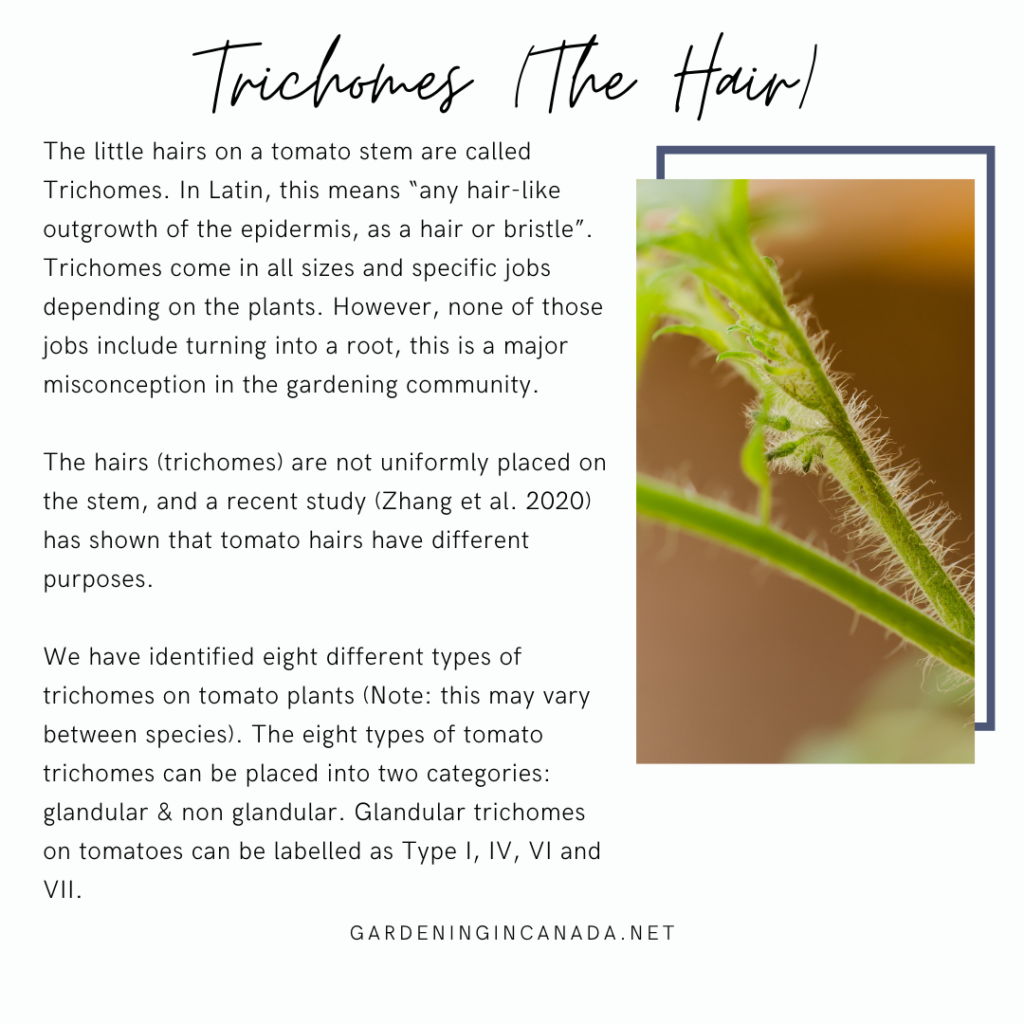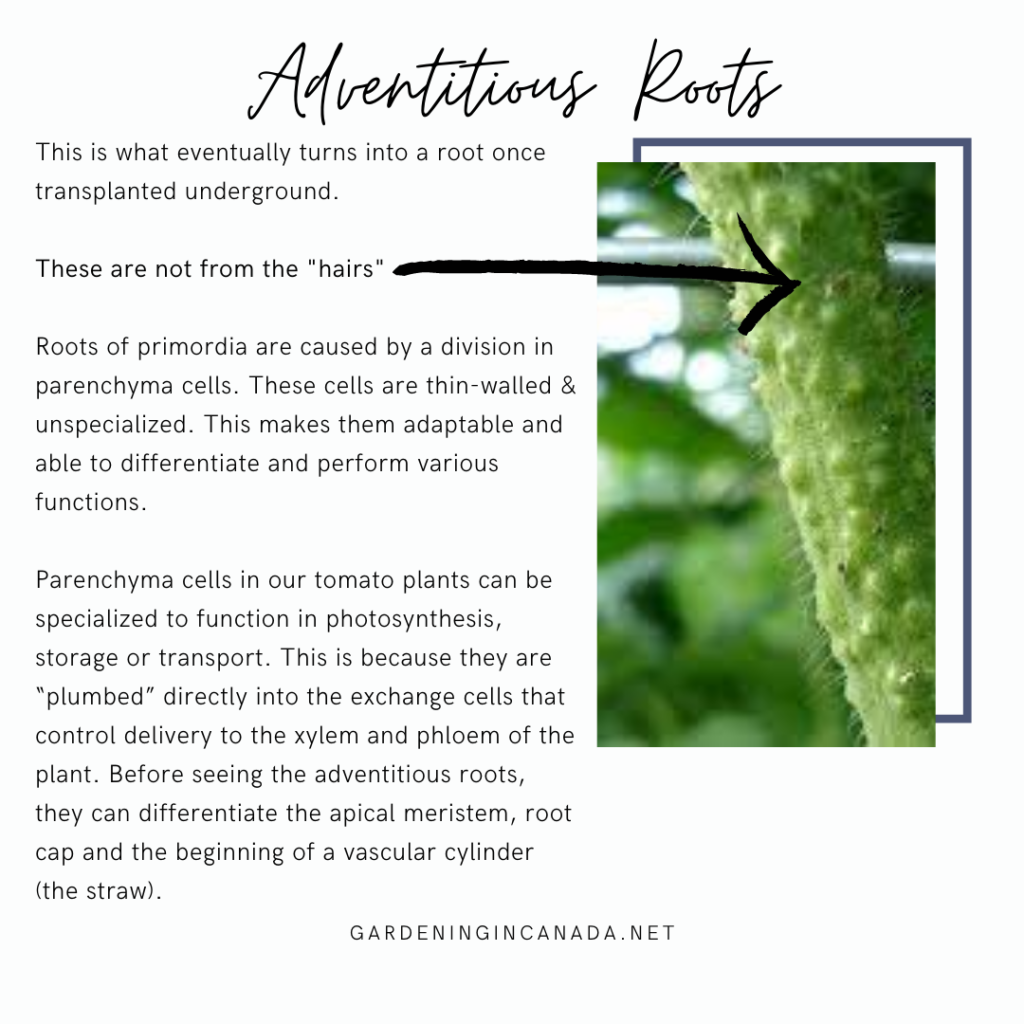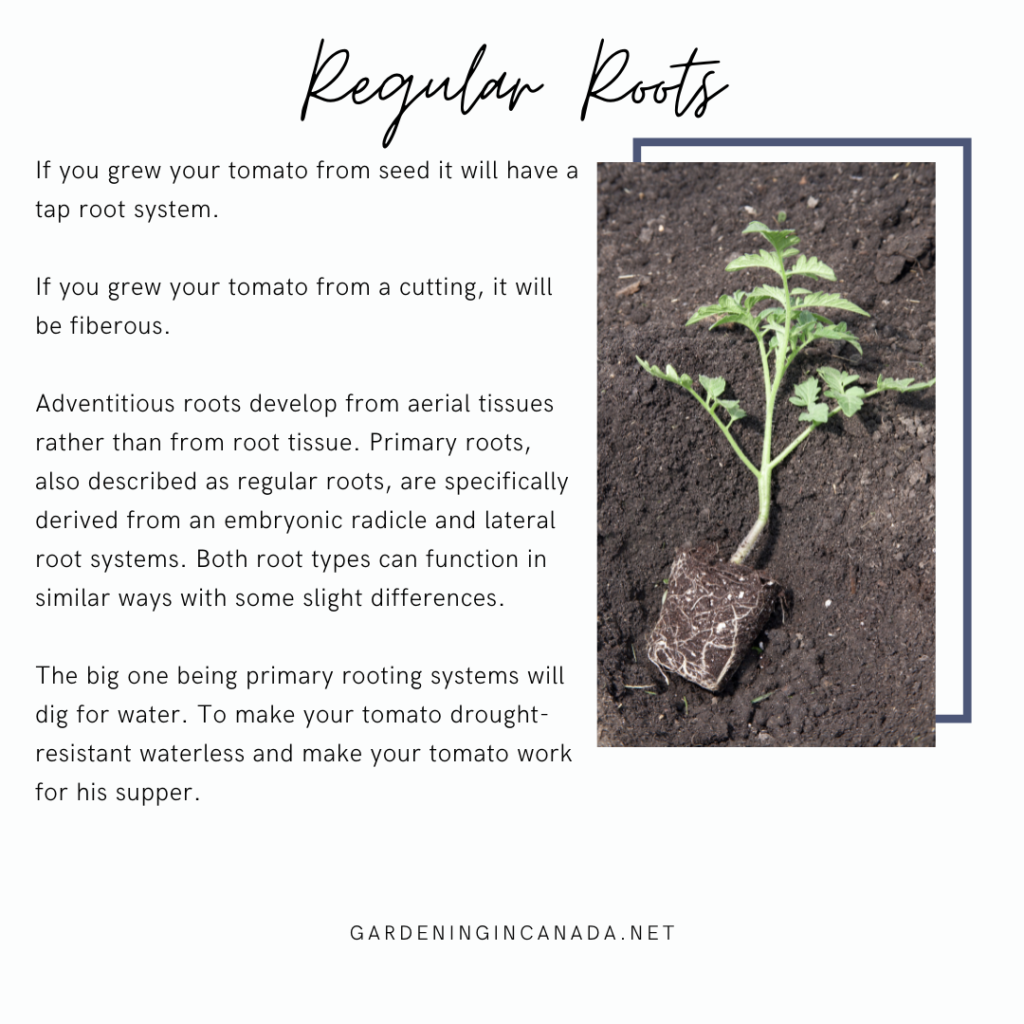- Canada’s Growing Zones Are Changing 2024 - January 12, 2024
- Attracting Wildlife To The Garden - May 16, 2023
- How To Garden Near A Septic Tank - May 9, 2023
Do you have tiny hairs on your tomato stem? Let’s look at the difference between trichomes vs. adventitious roots on tomato plants. What purpose do the tomato hairs plant on the plant? Are these roots in disguise or is there more to this story?
If you are new to this blog my name is Ashley and I am a soil scientist. I am located in a Canadian Zone 3 and a USDA Zone 4. I write articles, and make YouTube videos, Instagram & Facebook posts all designed for Canadians and Cold Climate gardeners using science-based methods. If you are looking for anything specific be sure to let me know in the comments down below.
What are the little hairs on my tomato stems?
The little hairs on a tomato stem are called Trichomes. In Latin, this means “any hair-like outgrowth of the epidermis, as a hair or bristle”. Trichomes come in all sizes and specific jobs depending on the plants. However, none of those jobs include turning into a root, this is a major misconception in the gardening community.

Do tomato trichomes become roots?
The purpose of the tiny hairs (trichomes) on plants is not to turn into roots. They actually play a multitude of roles! The hairs (trichomes) are not uniformly placed on the stem, and a recent study (Zhang et al. 2020) has shown that tomato hairs have different purposes. This was done through a scanning electron microscope (SEM) and a transmission electron microscope (TEM).
The purpose of the study was to identify the relationship between tomato trichomes & stress resistance. This was done by using various exposure treatments, which included low temperature, drought, disease and even insects (whiteflies in particular).
To learn more about planting depth check out this article.
Tomato Hairs (Trichomes) Are Not All Equal
We have identified eight different types of trichomes on tomato plants (Note: this may vary between species). The eight types of tomato trichomes can be placed into two categories: glandular & non glandular. Glandular trichomes on tomatoes can be labelled as Type I, IV, VI and VII.
Glandular tomato trichomes (under a microscope) are defined as:
- Consist of 6-10 cells
- Slender
- 2-3 mm in length
- Spherical
- Multicellular bases
- Small/round glandular cells on the tip.
The glands found on the hairy tip of glandular tomato trichome types I, IV, and VI are responsible for flavonoids, terpenoids and sugars.
No glandular trichomes on tomato plants consist of types II, III & V. These non glandular trichomes on tomatoes are identical to the glandular trichomes in appearance. But the one major difference is in the length, which is only 0.2-1 mm.
What do we know about having a mixture of trichome types on our tomato plants?
The study mentioned above looked at the different types of trichomes, their density and placement across different tomato species. They then use abiotic (weather) and biotic (bugs/disease) stressors to determine if the combinations and/or density of glandular and non-glandular structures made a difference in the plant’s ability to resist stress. This is what the test results came up with:
- Tomatoes with a higher density of both groups of trichomes (specific to types I (gland) & II (non-gland) were more tolerant to cold stressors.
- An abundance in non-glandular trichomes (not specific to type) can prompt drought resistance.
- Type III Non Glandular tomato trichomes combined with an above-average height in trichomes can result in pathogen resistance.
How does this apply to gardeners?
Trichomes Protecting Seedlings During Transplanting
Tomatoes with a higher density of trichomes per square mm of the plant can make the plant more tolerant to cold stressors. Small tomato plants have a lot more “hair” density-wise, than that of a larger tomato plants. The question I have for science: Is this one of the reasons why smaller tomato plants transplant better outside in cold climates when compared to larger ones?
One could assume or even experiment in their own gardens to see if this is the case. I would guess that the purpose of a higher density of trichomes on tomato seedlings comes down to two factors. The first one is temperature regulation against extremes such as cold and heat. The second factor is pest & herbivory protection.
Trichomes Protection Against Drought
As mentioned above the study showed that non-glandular trichomes on tomato plants are what is responsible for drought resistance. These short types of trichomes are often found on our leaves and as a gardener, you may notice adult plants tend to have more. It could be assumed that as the plant is exposed to more heat over the summer, more trichomes are made as “sunscreen”. Have you noticed more tomato hairs in a warmer summer?
What are the white bumps on my tomato plant?
These are what we call adventitious roots, also known as ariel roots. The houseplant community knows all about ariel roots and how they appear from seemingly nowhere. These knobs once placed in the ground will turn into regular root systems. They can be determined by weather conditions, cultivar and possible stress.
We often see adventitious roots after taking tomato cuttings or in a greenhouse environment. The cutting method we see this due to the displacement of auxin in the plant. But in the case of a greenhouse, it is likely caused by excess humidity.
What are adventitious roots?
Adventitious roots are also known as roots of primordia or fibrous roots. Roots of primordia are caused by a division in parenchyma cells. These cells are thin-walled & unspecialized (meaning they do not have a job… yet). This makes them adaptable and able to differentiate and perform various functions.
Parenchyma cells in our tomato plants can be specialized to function in photosynthesis, storage or transport. This is because they are “plumbed” directly into the exchange cells that control delivery to the xylem and phloem of the plant. Before seeing the adventitious roots, they can differentiate the apical meristem, root cap and the beginning of a vascular cylinder (the straw).

What are areal roots?
These are a form of adventitious root developed through environmental conditions or stressors. We often see areal roots on houseplants due to their nature. The important thing to remember is that adventitious roots are fibrous and surface dwellers. Taproots are meant for depth and development from a radical.
Why do adventitious roots look different than regular tomato roots?
Adventitious roots develop from aerial tissues rather than from root tissue. Primary roots, also described as regular roots, are specifically derived from an embryonic radicle and lateral root systems. Both root types can function in similar ways with some slight differences.
When looking at tomatoes specifically we have a primary taproot system, a lateral root system & the potential for areal derived adventitious roots. The regular tomato roots are the primary and lateral root systems. These roots act as anchors and also can help process nutrients, water etc. These roots dive deep in hopes of grabbing water and nutrients from lower in the soil profile.
The deeper your tomato tap root can go the better it will be at grabbing water and nutrients. This makes the plant better equipped to take on drought conditions. To help encourage taproot elongation of your tomato plant water less often but for longer. This means every 72 hours watering for 30 mins rather than every day for 10 mins.
The areal adventitious tomato roots will not dig deeper to help with drought or water capture. But these roots will add to stability and nutrient uptake once they have elongated.

Trichomes (Hairs) Vs. Adventitious Roots On Tomato Plants
When it comes to similarities between trichomes and adventitious roots there are only really two. The most obvious being it is an appendage on the main stem of our tomato stem. We can see this protrusion from the seedling to the adult stages of the plant. But the visual appearances are drastically different. One is very clearly a bump and the other is hair-like.
The second similarity is in helping the plant to regulate heat. The trichomes can act like sunblock to help regulate water losses. The movement of water in our plants is how they move nutrients but also cool themselves. If too much water is lost through “sweating” the plant can suffer. In the post about planting the depth of tomatoes, we explored the idea that the adventitious roots formed after transplanting. These root additions helped the plant regulate temperatures in hot soils.
The differences between tomato hairs and adventitious roots however are drastic! The trichomes are mostly just deterrents for pests and problems. The bumps of the tomato stem however are not deterrents at all.

Why do people think the hairs on tomatoes are roots?
It is because the trichomes disappear and adventitious roots appear. This most often happens underground and we don’t see the process. Once the trichomes are exposed to the excess moisture they are moved out of the way by the swelling of the stem. This stem swelling is caused by the adventitious roots coming to the surface. This sudden disappearance of skinny hairs turning into big noodle roots is likely the reason for this confusion.
